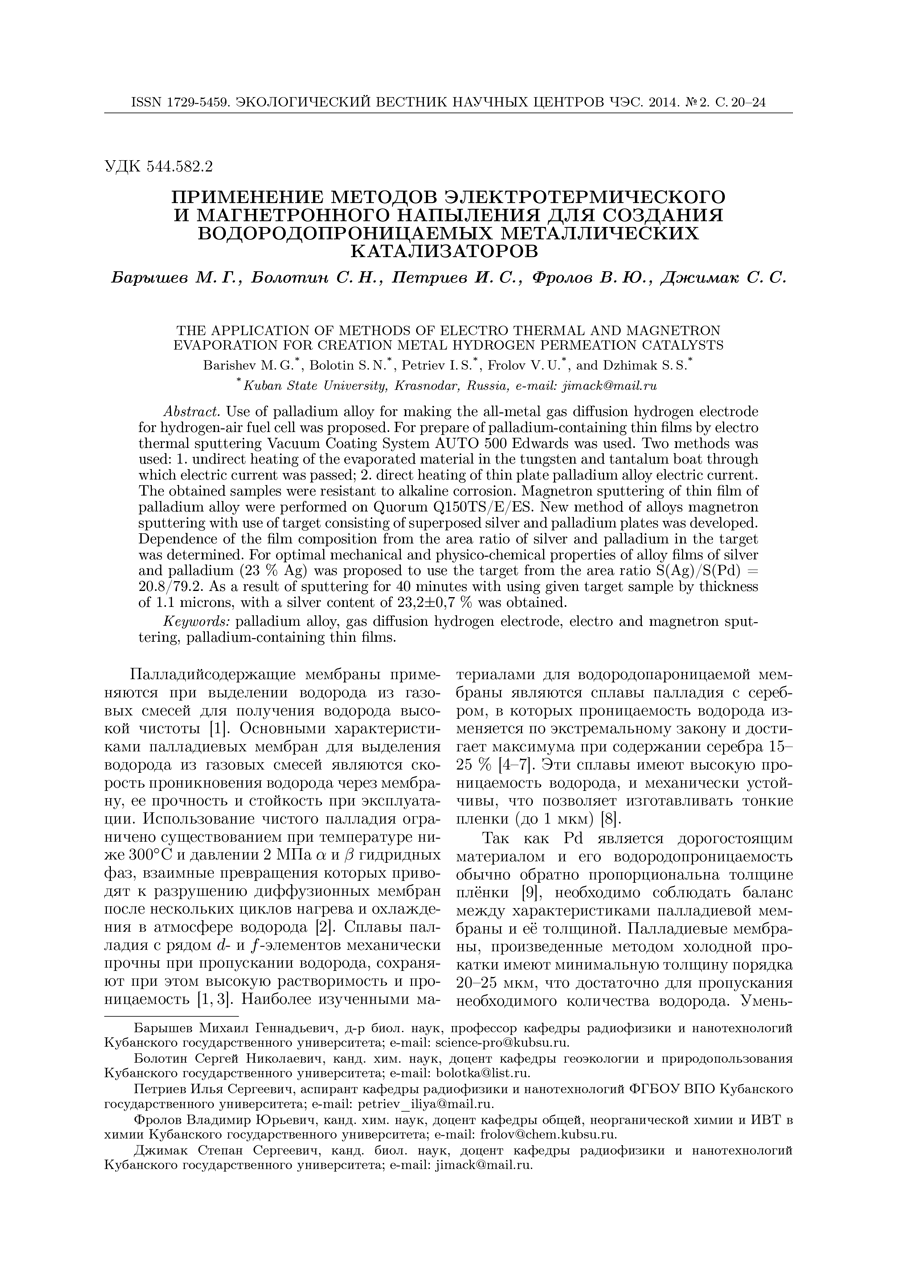The application of methods of electro thermal and magnetron evaporation for creation metal hydrogen permeation catalysts
UDC
544.582.2Abstract
Use of palladium alloy for making the all-metal gas diffusion hydrogen electrode for hydrogen-air fuel cell was proposed. For prepare of palladium-containing thin films by electro thermal sputtering Vacuum Coating System AUTO 500 Edwards was used. Two methods was used: 1. undirect heating of the evaporated material in the tungsten and tantalum boat through which electric current was passed; 2. direct heating of thin plate palladium alloy electric current. The obtained samples were resistant to alkaline corrosion. Magnetron sputtering of thin film of palladium alloy were performed on Quorum Q150TS/E/ES. New method of alloys magnetron sputtering with use of target consisting of superposed silver and palladium plates was developed. Dependence of the film composition from the area ratio of silver and palladium in the target was determined. For optimal mechanical and physico-chemical properties of alloy films of silver and palladium (23% Ag) was proposed to use the target from the area ratio S(Ag)/S(Pd) = 20.8/79.2. As a result of sputtering for 40 minutes with using given target sample by thickness of 1.1 microns, with a silver content of 23,2±0,7% was obtained.
Keywords:
palladium alloy, gas diffusion hydrogen electrode, electro and magnetron sputtering, palladium-containing thin filmsReferences
- Grashoff G.J., Pilkington C.E., Corti C.W. The purification of hydrogen: a review of the technology emphasizing the current status of palladium membrane diffusion. Platinum Metals Review, 1983, vol. 27, no. 4, pp. 157-169.
- Burhanov G.S., Gorina N.B., Kol'chugina N.B., Roshan N.R. Splavy palladija dlja vodorodnoj jenergetiki [The palladium alloys for hydrogen energy]. Rossijskij himicheskij zhurnal [Russian Chemical Journal], 2006, vol. L, no. 4, pp. 36-40. (In Russian)
- Knapton A.G. Palladium alloys for hydrogen diffusion membranes: a review of high permeability materials. Platinum Metals Review, 1977, vol. 21, no. 2, pp. 44-50.
- Mordkovich V.Z., Baichtock Y.K., and Sosna M.H. The large-scale production of hydrogen from gas mixtures: a use for ultra-thin palladium alloy membranes. International Journal of Hydrogen Energy, 1993, vol. 18, no. 7, pp. 539-544.
- Shu J., Adnot A., Grandjean B.P.A., Kaliaguine S. Structurally stable composite Pd-Ag alloy membranes: introduction of a diffusion barrier. Thin Solid Films, 1996, vol. 286, no. 1-2, pp. 72-79.
- Ali Jawad K, Newson E.J., Rippin D.W.T. Deactivation and regeneration of Pd/Ag membranes for dehydrogenation reactions. Journal of Membrane Science, 1994, vol. 89, no. 1-2, pp. 171-184.
- Paglieri S.N., Way J.D. Innovations in palladium membrane research. Separation & Purification Reviews, 2002, vol. 31, no. 1, pp. 1-169.
- Bredesen R., Klette H. Method of manufacturing thin metal membranes. Patent 6086729 US.
- Shu J., Grandjean B.P.A., Van Neste A., Kalaguine S. Catalytic palladium-based membrane reactors: a review. Canadian Journal of Chemical Engineering, 1991, vol. 69, pp. 1036-1060.
- Elkina I.B., Meldon J.H. Hydrogen transport in palladium membranes. Desalination, vol. 147, no. 1-3, pp. 445-448.
- Amandusson H., Ekedahl L.G., Dannetun H. Hydrogen permeation through surface modified Pd and PdAg membranes. Journal of Membrane Science, 2001, vol. 193, no. 1, pp. 35-47.
- Peters T.A., Tucho W.M., Ramachandran A., Stange M., Walmsley J.C., Holmestad R., Borg A., Bredesen R. Thin Pd-23%Ag/stainless steel compositemembranes: long-term stability, life-time estimation and post-process characterization. Journal of Membrane Science, 2009, vol. 326, no. 2, pp. 572-581.
- Savickij E.M., Poljakova V. P., Gorina N.B., Roshan N.R. Metallovedenie platinovyh metallov [Physical metallurgy of platinum metals]. Moscow, Metallurgija, 1975, 278 p. (In Russian)
- Blagorodnye metally. Spravochnik [Noble metals. The guide]. Moscow, Metallurgija, 1984, 592 p. (In Russian)
- Himicheskaja jenciklopedija [Chemical encyclopedia]. Vol. 3. Medi - Polimernye. Moscow, 1995, 641 p. (In Russian)
- Himicheskaja jenciklopedija [Chemical encyclopedia]. Vol. 4. Polimernye - Tripsin. Moscow, 1995, 639 p. (In Russian)
Downloads
Issue
Pages
Submitted
Published
How to Cite
Copyright (c) 2014 Barishev M.G., Bolotin S.N., Petriev I.S., Frolov V.Yu., Dzhimak S.S.

This work is licensed under a Creative Commons Attribution 4.0 International License.




